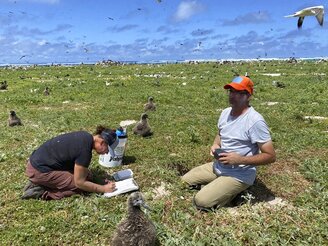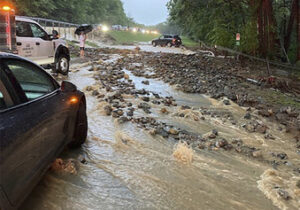Moving species emerges as last resort as climate warms
4 min read
In this photo provided by the Pacific Rim Conservation, wildlife workers relocate Tristram’s storm petrels on Hawaii’s Tern Island, on March 29, 2022. Scientists are making a dramatic effort to save the birds in Hawaii by moving them to an island they never had inhabited. (L. Young/Pacific Rim Conservation via AP)
In a desperate effort to save a seabird species in Hawaii from rising ocean waters, scientists are moving chicks to a new island hundreds of miles away.
Moving species to save them — once considered taboo — is quickly gaining traction as climate change upends habitats. Similar relocations are being suggested for birds, lizards, butterflies and even flowers.
Concerns persist that the novel practice could cause unintended harm the same way invasive plants and animals have wreaked havoc on native species.
But for the Tristram’s storm petrels on northeastern Hawaii’s Tern Island, which is just 6 feet (1.8 meters) above sea level, the relocation of about 40 chicks to artificial burrows more than 500 miles (805 kilometers) away on Oahu could offer new hope. The species is considered vulnerable to extinction, and the goal is for the young petrels return to their new home when old enough to breed.
“Tern Island is washing away,” said biologist Eric VanderWerf of the nonprofit Pacific Rim Conservation. “Climate change is causing a greater need for this — for taking a species outside its known historical range.”
A pending change to the U.S. Endangered Species Act by the Biden administration would make it easier to relocate some of the most imperiled species to places where they’ve not previously been recorded.
In response, state wildlife officials and scientists have suggested moving a portion of some species struggling with climate change, including Key deer of southern Florida, the Karner blue butterfly of the Midwest and Northeast, desert flowers in Nevada and California and the St. Croix ground lizard in the Virgin Islands.
Republicans in western states — including Montana, New Mexico and Arizona — are against the proposal saying it could wreak ecological havoc as “invasive species” get purposefully introduced.
The proposal, which federal officials expect to finalize in June, reflects a “fundamental shift in the way we think of species protection and conservation,” said University of Notre Dame biologist Jason McLachlan.
The issue goes beyond endangered species, McLachlan said, and raises questions about what should be considered “native” now that shifting temperatures are pushing some species to higher elevations or toward the planet’s poles.
Comparable temperature shifts in the past occurred over millennia, but the present one is happening over just decades and is drastically upending ecosystems. “Eventually we’re going to have to start thinking about it in ways that will make people — including me — uncomfortable,” he said. “To say this species is OK and this species is not OK, that’s asking a lot of human beings.”
To save storm petrels, VanderWerf said, scientists need to act before populations have crashed. “In 30 years, these birds will certainly be rare, if we don’t do something about it,” he said.
Relocation of species outside historical ranges is still a rarity, but U.S. wildlife officials have identified numerous threatened and endangered plants and animals already being affected by climate change: glacial stoneflies in Montana, emperor penguins in Antarctica, the Mt. Rainier ptarmigan, the saltmarsh sparrow of the Atlantic coast and numerous birds of Hawaii.
U.S. Fish and Wildlife Service spokesperson Karen Armstrong said there are no current proposals to establish new populations of those particular species. “In the future, some species’ ranges may shift due to climate change, or their current habitats might become unsuitable due to invasive species encroachment,” Armstrong said in an email. “We view experimental population establishment outside of their historical ranges as a potential tool for their management and conservation.”
One plan now being considered by U.S. wildlife officials concerns birds native to Guam, where kingfishers were decimated by brown tree snakes accidentally brought to the island around 1950 on military cargo ships.
The last 29 wild Guam kingfishers were captured in the 1980s and have been bred in captivity to buy time. Under a pending proposal, nine kingfishers would be released back into the wild beginning this year on Palmyra Island, more than 3,600 miles (5,800 kilometers) away.
If a relocation is successful, the kingfishers would become one of the few species ever upgraded from “extinct in the wild” to “critically endangered.”
The hope is that the Guam kingfisher, also known locally as sihek, will eventually be returned to their native island, if the tree snake is controlled, said Erica Royer, a bird expert at the Smithsonian Conservation Biology Institute in Washington, D.C.
“This kind of intensive management is necessary for us to have a reasonable shot at holding onto some species,” said Don Lyons with National Audubon Society’s Seabird Institute.
Yet the potential danger — and scientific debate — lies in what humans can’t predict. Humanity has been moving species around for centuries, often inadvertently and sometimes causing great harm.
Examples abound: Asian carp have spread through rivers and streams across the U.S. Starlings from Europe destroy crops and drive out songbirds. Zebra mussels from Eurasia decimate native populations. And kudzu vines from Japan planted to stabilize soils have spread to dozens of states where they choke out other plants.
Scientist Mark Schwartz at the University of California, Davis said he was initially skeptical of moving species for conservation when biologists began discussing the idea about a decade ago. The rapid rate of extinctions more recently has him thinking that sitting idle could be a costly error.
“Many, many species” must be moved or could go extinct, said James Watson, a conservation scientist at the University of Queensland in Australia, where increasingly severe, climate-fueled wildfires have forced conversations on relocations. Unprecedented fires three years ago likely destroyed the last habitats of some endangered species, he said.
“We’ve already played Russian Roulette with the climate, we’re already on that ski run – we might as well take some more risks.”








